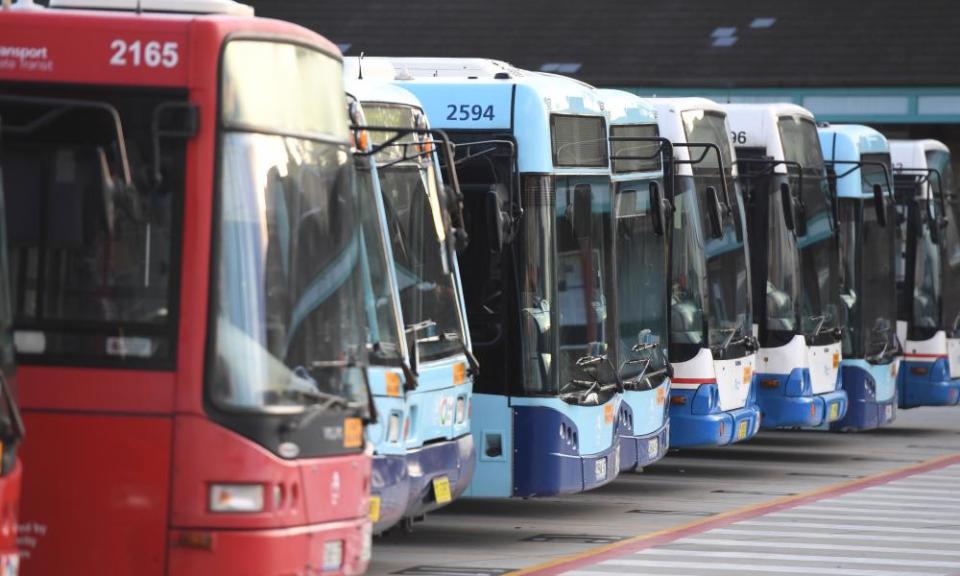More buses in disadvantaged areas better value than major transport projects, Australian research finds

Increasing the frequency of local bus routes in underprivileged suburbs can provide a better return on taxpayer investment “by a considerable margin” than projects such as Melbourne’s suburban rail loop, researchers have found.
According to the paper by researchers at the University of Sydney and the University of Melbourne, state governments in Australia are far more likely to spend billions on major infrastructure projects such as highways and new rail lines than smaller projects because the time savings they deliver are easier to quantify, which makes it easier to attract political support.
Related: ‘Tolls discriminate’: western Sydney residents face $60 a day levy to drive into CBD
But governments are failing to fully calculate the flow-on financial benefits of smaller public transport projects in poorer urban fringe suburbs, such as lower crime, increased employment, better health outcomes and improved social inclusion.
Transport planners have long considered the connection between mobility and social inclusion. They rely on a formula that calculates the monetary value to society of public transit trips based on an individual’s household income, employment status, social support, participation in community such as library or sports events and political activity.
Sign up for Guardian Australia’s free morning and afternoon email newsletters for your daily news roundup
The new research bolsters that formula by adding a measure for neighbourhoods – and how at-risk residents are of social exclusion – based on data including: the proportion of residents aged 15 or older without a university or school education or English skills; one-parent families; households without a car; and the number of people employed as labourers, machinery operators or service workers.
People who are socially excluded commonly have a higher risk of being unemployed, having poorer mental and physical health, being less socially connected and some will be more likely to engage in crime and substance abuse – which has consequential costs for the wider economy, the paper said.
The updated formula would give governments better evidence to fund less glamorous, low-patronised public transport projects that would ordinarily be overlooked or cancelled, ultimately improving social inclusion.
Lead author John Stanley is an adjunct professor of sustainable transport and social inclusion at the University of Sydney who once headed Bus Association Victoria – a group that contributed part of the cost of undertaking his research. Stanley said because all public transport in Australia runs at a loss, illustrating every flow-on benefit of a project is an important way to help governments decide what to fund.
He said that in new suburbs on the urban fringes of major Australian cities, his formula showed that local bus services would only need to carry eight or nine passengers an hour for its societal benefits to outweigh the financial cost of running the bus.
“You’d be hard-pressed to find a government that wouldn’t cut a bus service, let alone start a new bus service, with just eight or nine passengers an hour.” In regional towns, he estimates just six passengers per hour on a bus outweigh the cost.
Stanley’s formula calculates the societal value of any public transport trip at $22.75 for a person living in an average-income household. For a household with half the average income, the societal value of the trip roughly doubles to more than $45. For someone from a household with double the average income, the societal value of a public transport trip is just over $10.
Related: Myki cards to make way for phones on Victoria’s public transport system, Daniel Andrews says
While not discounting the benefit of city-wide transit projects, Stanley says more needs to be done to level the playing field for less central communities.
“Mass transit is about getting bums on seats, but social transit is not just about bums on seats, it’s about whose bums get on the seats, and how much their life could be changed through improved social mobility and inclusion.”
Stanley has researched his formula in the context of some Australian cities. He found that without considering the full value of social inclusion, Sydney’s Parramatta light rail would stack up as a “white elephant”. He also found a sound business case for a hypothetical plan to double the frequency of buses in western Sydney.
In Melbourne, planners included part of Stanley’s updated formula when making the case for the ambitious suburban rail loop. But Stanley argued that if governments used the formula to assess all transport options for the city they would find that funding local bus and tram routes would be a far better use of money.
“Projects on the fringes are going to give you better returns than the suburban rail loop by a considerable margin,” he said.
Stanley added that while building roads was popular with governments to allow residents to travel faster, such a mentality “expands a city” and “encourages people to travel further not more local”, providing less social inclusion benefit.

 Yahoo Sport
Yahoo Sport 





































